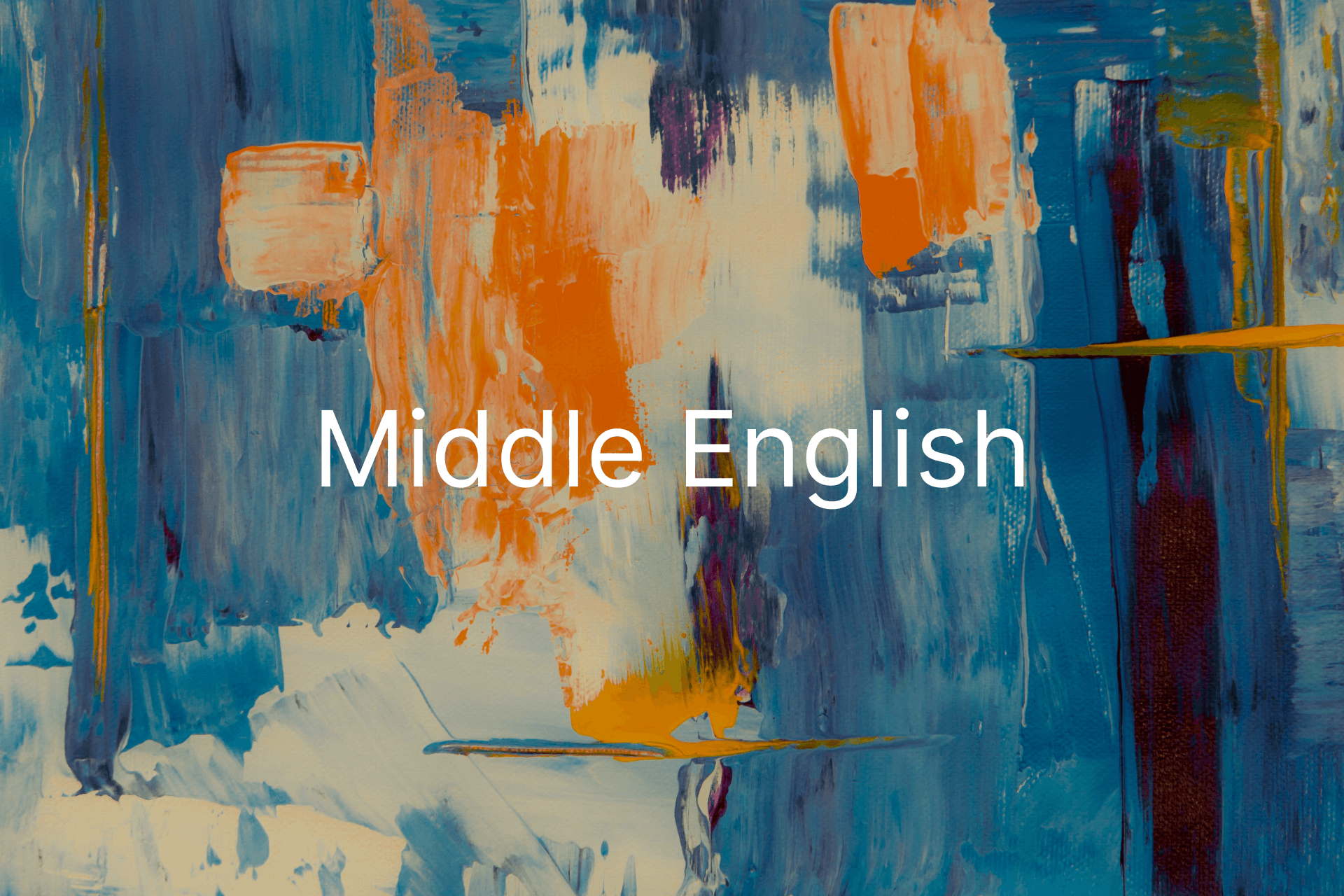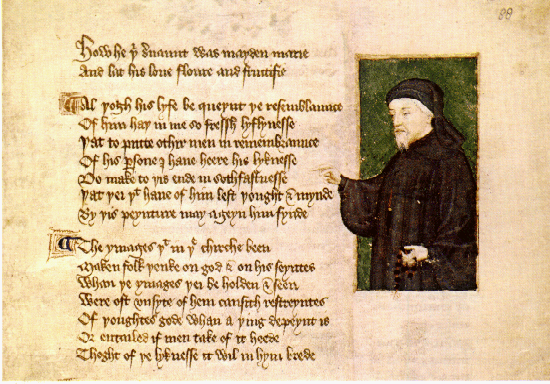Middle English: A Journey Through Time and Language

TABLE OF CONTENTS
Welcome to the fascinating world of Middle English, the form of the English language spoken from approximately 1100 to 1500. This pivotal period, spanning the High and Late Middle Ages, witnessed English transform from the heavily inflected Old English of Beowulf into a language recognizably closer to what we speak today. In this comprehensive guide, we’ll explore what Middle English is, its rich historical context, distinctive linguistic features, major literary achievements, and practical strategies for reading it. You’ll also have the opportunity to test your understanding with an interactive quiz and discover resources to help navigate challenging passages.
What is Middle English?
Discover what defines Middle English and why this period is crucial in the evolution of the English language.
Middle English represents the evolutionary stage of the English language that emerged following the Norman Conquest of 1066 and continued until approximately 1500. Linguists typically divide this period into two phases: Early Middle English (c. 1100-1300) and Late Middle English (c. 1300-1500). This era serves as a crucial bridge between Old English—a heavily inflected Germanic language with complex case systems—and Modern English, which relies primarily on word order and simplified grammar.
The transformation wasn’t immediate. The decades following 1066 saw a gradual shift as Norman French influence permeated English society, while the underlying Germanic structure of English adapted and simplified over generations.
Historical Context: The Norman Conquest and Its Linguistic Legacy
Explore the historical events and social changes that shaped the development of Middle English.
The Norman Conquest of 1066 fundamentally altered England’s linguistic landscape. When William the Conqueror defeated King Harold II at the Battle of Hastings, he didn’t merely change political power—he initiated a linguistic revolution that would reshape English forever.
The Trilingual Society
Post-conquest England became a complex multilingual society:
-
Latin remained the language of the Church, scholarship, and formal documentation
-
Anglo-Norman (a variety of Old French) dominated the royal court, legal proceedings, and aristocratic circles
-
English persisted among the common people, craftsmen, and rural populations
This linguistic stratification created what scholars call “domain specialization,” where different languages served specific social and professional functions.
Waves of Linguistic Influence
The transformation of English occurred through several key influences:
French and Norman Impact: The Norman elite introduced approximately 10,000 French loanwords into English vocabulary, particularly in areas of governance (“parliament,” “government”), law (“court,” “judge,” “jury”), military affairs (“army,” “battle,” “siege”), cuisine (“beef,” “pork,” “dinner”), and refined culture (“art,” “music,” “fashion”).
Continuing Norse Legacy: Earlier Viking settlements (8th-11th centuries) had already contributed fundamental vocabulary to English. Words like “sky,” “egg,” “window,” “husband,” and “skill” became more prominent during the Middle English period, especially in northern dialects where Scandinavian settlement had been heaviest.
Latin Scholarly Tradition: As literacy expanded and universities developed, Latin contributed numerous learned terms, particularly in areas of religion, science, and philosophy.
The Gradual Resurgence of English
By the 13th century, English began reasserting itself. The loss of Normandy to France in 1204 weakened ties between England and French-speaking territories. By 1362, English had become the official language of Parliament, and Geoffrey Chaucer’s works in the late 14th century demonstrated that English could achieve the same literary sophistication as French or Latin.
Key Features of Middle English
Learn about the major linguistic changes in vocabulary, grammar, pronunciation, and spelling that distinguish Middle English from Old and Modern English.
Middle English underwent profound changes across all aspects of language structure. Understanding these changes helps explain both the challenges and rewards of reading Middle English texts.
Vocabulary Expansion and Layering
The Middle English lexicon became remarkably enriched through borrowing:
-
Germanic Core: Basic vocabulary remained Germanic (“house,” “love,” “water,” “bread”)
-
French Overlay: Sophisticated and technical terms came from French (“justice,” “beauty,” “government”)
-
Latin Additions: Abstract and learned concepts derived from Latin (“education,” “philosophy,” “science”)
-
Norse Integration: Everyday words from Old Norse became standard (“they,” “them,” “their”)
This layering created synonymous pairs where Germanic, French, and Latin words coexisted with subtle differences in register and meaning (e.g., “kingly/royal/regal”).
Grammatical Simplification
Middle English dramatically simplified Old English grammar:
Case System Collapse: Old English had four distinct noun cases (nominative, accusative, genitive, dative) with complex adjective agreements. Middle English largely eliminated these distinctions, retaining only traces in pronouns and some fossilized expressions.
Verb System Changes: While Old English verbs had complex person and number endings, Middle English simplified these patterns. The infinitive typically ended in -en (e.g., “loven” = to love), and past participles often retained the ge- prefix (later becoming y-).
Word Order Stabilization: As inflectional endings disappeared, word order became more fixed. The Subject-Verb-Object pattern became dominant, though some flexibility remained, especially in poetry.
Pronunciation Evolution
Middle English pronunciation differed significantly from both Old and Modern English:

Diagram of the changes in English vowels during the Great Vowel Shift
Vowel System: Most vowels were pronounced more like their continental European counterparts. The letter ‘a’ was pronounced [a] (as in “father”), ‘e’ was [ɛ] or [e], and ‘i’ was [i] (as in “machine”).
The Great Vowel Shift: Beginning in the 15th century, this systematic change in long vowel pronunciation started the transformation toward Modern English sounds. For example, Middle English “tyme” [ti:mə] became Modern English “time” [taɪm].
Consonantal Differences: Many consonants now silent were pronounced: the ‘k’ in “knight,” the ‘l’ in “half,” and the ‘gh’ in “night” (pronounced [x], like German “ach”).
Orthographic Variation and Standardization
Spelling in Middle English reflects its transitional nature:

Regional Variation: Without standardized spelling, scribes wrote phonetically, creating regional variants. The word “church” might appear as “chirche” (Southern), “churche” (Midlands), or “kirk” (Northern).
French Spelling Conventions: Norman scribes introduced French spelling patterns, such as ‘qu’ for Old English ‘cw’ (“queen” instead of “cwen”) and ‘gh’ for the [x] sound.
The Chancery Standard (a form of written English used by government offices in late Middle English, which influenced later standardization)
| Aspect | Old English | Middle English | Modern English |
|---|---|---|---|
| Case System | 4 cases, complex | Mostly eliminated | Minimal (pronouns only) |
| Word Order | Flexible (SOV/SVO) | Increasingly SVO | Fixed SVO |
| Vocabulary | Germanic core | Germanic + French/Latin | Highly mixed |
| Spelling | Fairly consistent | Highly variable | Standardized |
Middle English Literature: A Golden Age
Uncover the literary achievements and regional diversity of Middle English literature, from Chaucer to anonymous poets.
Despite French cultural dominance, Middle English produced extraordinary literary works that showcase the language’s growing sophistication and regional diversity.
Major Literary Achievements
Geoffrey Chaucer (c. 1340-1400) The Canterbury Tales represents the pinnacle of Middle English literature. Written in the London dialect, Chaucer’s collection of pilgrims’ stories demonstrates remarkable linguistic versatility, social observation, and literary artistry. His works helped establish the London dialect as a literary standard.
William Langland (c. 1330-1386) Piers Plowman, a complex religious allegory, exists in multiple versions representing different dialects. This work shows how Middle English could handle sophisticated theological and social criticism.
The Gawain Poet (anonymous, late 14th century) Sir Gawain and the Green Knight, written in the Northwest Midlands dialect, exemplifies the alliterative revival (the resurgence of alliterative verse in 14th-century English poetry). Its sophisticated vocabulary and poetic technique rival any contemporary European literature.
Religious and Didactic Literature
-
Ancrene Wisse (early 13th century): A guide for anchoresses, representing early West Midlands prose
-
The Katherine Group: Saints’ lives demonstrating the development of English prose style
-
Ormulum (c. 1200): An early biblical commentary with unique phonetic spelling system
Regional Literary Traditions
Middle English literature flourished in various regional centers:
-
London: Became increasingly dominant, especially through Chaucer’s influence
-
West Midlands: Produced the Gawain poet and important religious texts
-
North: Maintained strong alliterative traditions and Norse vocabulary
-
East Midlands: Generated diverse religious and secular works
How to Read Middle English: A Practical Guide
Get practical tips and resources for reading and understanding Middle English texts, even as a beginner.
Reading Middle English requires patience and strategy, but it becomes increasingly rewarding with practice.
Essential Reading Strategies
Phonetic Approach: Middle English spelling often reflects pronunciation more directly than Modern English. Try sounding out unfamiliar words—many will become recognizable when pronounced aloud.
Expect Variation: The same word may be spelled differently even within a single text. Don’t assume variant spellings indicate different words.
Understand Scribal Conventions:
-
Final ‘e’ was often pronounced [ə] (schwa)
-
‘y’ frequently represents ‘i’ (“lyf” = life)
-
‘u’ and ‘v’ were often interchangeable
-
Double letters might indicate pronunciation differences
Recognize Common Patterns:
-
Infinitives often end in -en (“loven,” “goon”)
-
Past participles may have y- prefix (“ygone,” “ysent”)
-
Plural nouns often end in -es or -en
-
Third person singular verbs typically end in -eth or -es
Linguistic Tools and Resources
Essential References:
-
Middle English Dictionary (University of Michigan): Comprehensive historical dictionary
-
Oxford English Dictionary: Provides etymological information and historical citations
-
A Chaucer Glossary by Norman Davis: Specifically helpful for Chaucerian texts
Pronunciation Guides:
-
Harvard’s Chaucer Website offers audio recordings
-
The International Phonetic Alphabet helps with systematic pronunciation study
Modern Translations: While learning to read Middle English directly is ideal, translations can help verify understanding and provide confidence when tackling difficult passages. For those who find certain passages particularly challenging, you can use our Middle English translator at OpenL Translate to get a Modern English version of the text. This tool can be especially helpful for beginners or when tackling more complex literary works.
Step-by-Step Reading Method
-
First Reading: Read through for general sense, not worrying about every word
-
Second Reading: Look up unfamiliar words and make marginal notes
-
Third Reading: Read aloud to hear the rhythm and flow
-
Analysis: Consider grammar, word choice, and literary effects
Interactive Challenge: Test Your Middle English Skills
Test your knowledge and understanding of Middle English with fun and interactive exercises.
Let’s explore a famous passage from The Canterbury Tales “General Prologue.” Try to understand as much as possible before checking the glossary.
1. Vocabulary Challenge
| Middle English | Options | Modern English |
|---|---|---|
| 1. shoures | a. drought, b. showers, c. flowers | |
| 2. soote | a. soot, b. suit, c. sweet | |
| 3. droghte | a. draft, b. drought, c. brought | |
| 4. perced | a. pierced, b. perceived, c. priced | |
| 5. veyne | a. vain, b. vine, c. vein | |
| 6. swich | a. switch, b. such, c. swift | |
| 7. licour | a. liquor, b. liquid, c. lecture | |
| 8. vertu | a. virtue, b. virtual, c. vertical | |
| 9. engendred | a. endangered, b. engendered, c. gendered | |
| 10. flour | a. floor, b. flower, c. flour | |
| 11. eek | a. each, b. eke, c. also | |
| 12. breeth | a. breath, b. breathe, c. breed | |
| 13. holt | a. halt, b. wood, c. hole | |
| 14. heeth | a. heath, b. heat, c. hearth | |
| 15. croppes | a. crops, b. cups, c. craps |
Answers: 1-b, 2-c, 3-b, 4-a, 5-c, 6-b, 7-b, 8-a, 9-b, 10-b, 11-c, 12-a, 13-b, 14-a, 15-a
2. Translation Exercise
Try translating the following Middle English sentence into Modern English. Write your answer below, then check the provided translation.
“Whan that Aprille with his shoures soote”
Modern English answer: “When April with its sweet showers”
3. Pronunciation Practice
Listen to a recording of the passage and try to read it aloud, imitating the pronunciation.
https://www.youtube.com/watch?v=M3y88HGb6Hc
The Transition to Early Modern English
See how Middle English evolved into Early Modern English through social, cultural, and linguistic changes.
By the late 15th century, several factors accelerated the transition from Middle English to Early Modern English:
The Printing Revolution
William Caxton’s introduction of printing to England (c. 1476) standardized texts and reduced regional variation. Early printers, primarily based in London, helped establish the East Midlands/London dialect as the emerging standard.
The Great Vowel Shift Continues
This systematic change in long vowel pronunciation, beginning in the 15th century, created the Modern English vowel system. Words that rhymed in Chaucer’s time (like “name” and “shame”) underwent parallel changes, maintaining their rhyme relationships while transforming their sounds.
Social and Cultural Changes
The rise of the merchant class, increased literacy, and the Protestant Reformation’s emphasis on vernacular religious texts all contributed to English becoming more standardized and sophisticated.
Renaissance Influence
The revival of classical learning introduced numerous Latin and Greek borrowings, further expanding English vocabulary and creating the lexically rich language of Shakespeare and his contemporaries.
Why Study Middle English Today?
Discover the value and relevance of studying Middle English in the modern world.
Understanding Middle English offers unique insights into:
Language Evolution: Witnessing how languages change systematically over time Cultural History: Understanding medieval English society through its literature Modern English: Recognizing the historical roots of contemporary vocabulary and grammar Literary Appreciation: Accessing masterpieces in their original linguistic glory Linguistic Awareness: Developing sensitivity to language variation and change
Middle English in Modern English
Explore how Middle English continues to shape the words, expressions, and spelling of modern English.
Many features of modern English have their roots in the Middle English period. Here are some examples:
| Middle English Origin | Modern English Example | Note |
|---|---|---|
| they, them, their | they, them, their | Borrowed from Old Norse during Middle English |
| court, judge, government | court, judge, government | Borrowed from Norman French |
| night (spelled ‘nyght’) | night | ’gh’ spelling from Middle English, now silent |
| plural -es ending | houses, foxes | Became standard in Middle English |
| word order (SVO) | The cat eats fish. | Fixed word order developed in Middle English |
| double letters | butter, letter | Used to indicate pronunciation differences |
-
Many everyday words and legal, cultural, and culinary terms entered English during this period.
-
Some spelling conventions, like ‘qu’ for ‘cw’ (queen vs. cwen), also date from Middle English.
-
Expressions such as ‘by and large’ and ‘at length’ have medieval roots.
Understanding these connections helps reveal the living legacy of Middle English in our daily language.
Conclusion
Middle English is not just a stage in the history of English—it is a living bridge between the past and present, full of stories, sounds, and surprises.
By exploring Middle English, you’re not only learning about language change, but also connecting with the voices and imaginations of people from centuries ago. The effort you invest in reading a medieval text, listening to a Chaucerian passage, or exploring a digital manuscript will reward you with new perspectives and a deeper appreciation for the English we speak today.
Why not pick up a passage from Chaucer, try the OpenL Middle English Translator, or listen to a medieval poem aloud? Dive into the resources and challenges above, and discover for yourself the richness and beauty of Middle English. The journey may be challenging, but the rewards are truly unique—and you’ll be joining a tradition of readers and learners that stretches back more than 500 years.
Start your adventure today!
Sources and Further Reading
Primary Sources
-
Chaucer, Geoffrey. The Canterbury Tales. Ed. Larry Benson. The Riverside Chaucer. 3rd ed. Oxford University Press, 2008.
-
Sir Gawain and the Green Knight. Ed. J.R.R. Tolkien and E.V. Gordon. 2nd ed. Oxford University Press, 1967.
-
Langland, William. Piers Plowman: The B Version. Ed. George Kane and E. Talbot Donaldson. Athlone Press, 1975.
Historical and Linguistic Studies
-
Baugh, Albert C., and Thomas Cable. A History of the English Language. 6th ed. Routledge, 2012.
-
Blake, Norman F. The Cambridge History of the English Language, Volume II: 1066-1476. Cambridge University Press, 1992.
-
Burrow, J.A., and Thorlac Turville-Petre. A Book of Middle English. 3rd ed. Blackwell, 2005.
-
Crystal, David. The Stories of English. Overlook Press, 2004.
-
Fennell, Barbara A. A History of English: A Sociolinguistic Approach. Blackwell, 2001.
Language References
-
Kurath, Hans, et al., editors. Middle English Dictionary. University of Michigan Press, 1952-2001. Online:
-
Davis, Norman. A Chaucer Glossary. Oxford University Press, 1979.
-
Oxford English Dictionary. Oxford University Press. Online:
Literary Studies
-
Pearsall, Derek. The Canterbury Tales. George Allen & Unwin, 1985.
-
Spearing, A.C. The Gawain-Poet: A Critical Study. Cambridge University Press, 1970.
-
Turville-Petre, Thorlac. The Alliterative Revival. D.S. Brewer, 1977.
Digital Resources
-
The Middle English Compendium. University of Michigan.
-
Harvard’s Chaucer Website.
-
The Corpus of Middle English Prose and Verse. University of Michigan.
Pronunciation and Audio Resources
-
Solopova, Elizabeth. Chaucer’s Language. In Oxford Guides to Chaucer. Oxford University Press, 2000.
-
Sounds of Speech: Middle English. University of Iowa.
Scholarly Articles
-
Cannon, Christopher. “The Myth of Origin and the Making of Chaucer’s English.” Speculum 71.3 (1996): 646-675.
-
Rothwell, William. “The Trilingual England of Geoffrey Chaucer.” Studies in the Age of Chaucer 16 (1994): 45-67.
-
Smith, Jeremy J. “Standard Language in Early Middle English?” Language Standardization and Language Change. Ed. Laura Wright. Cambridge University Press, 2000. 125-139.


